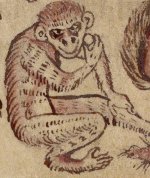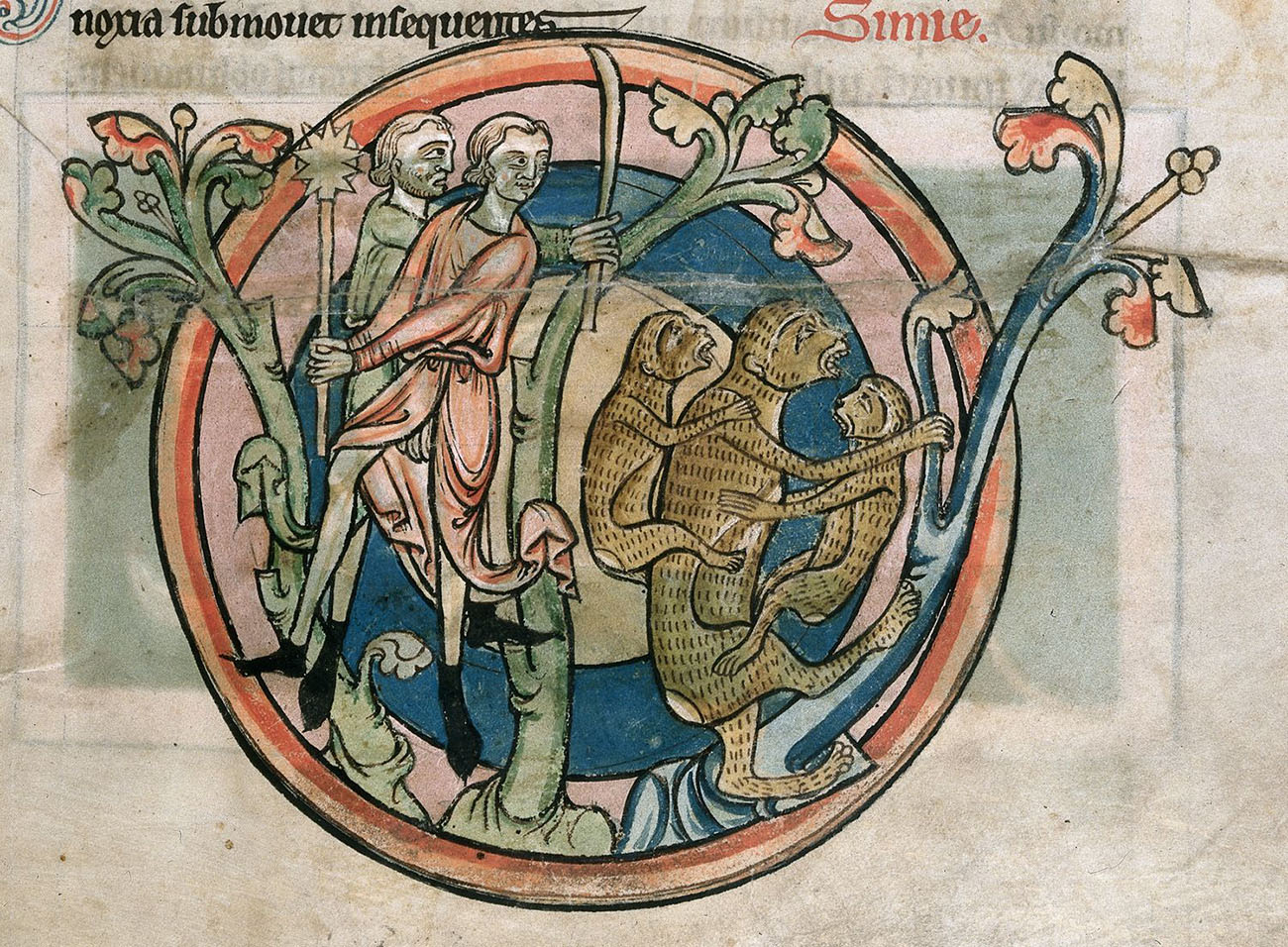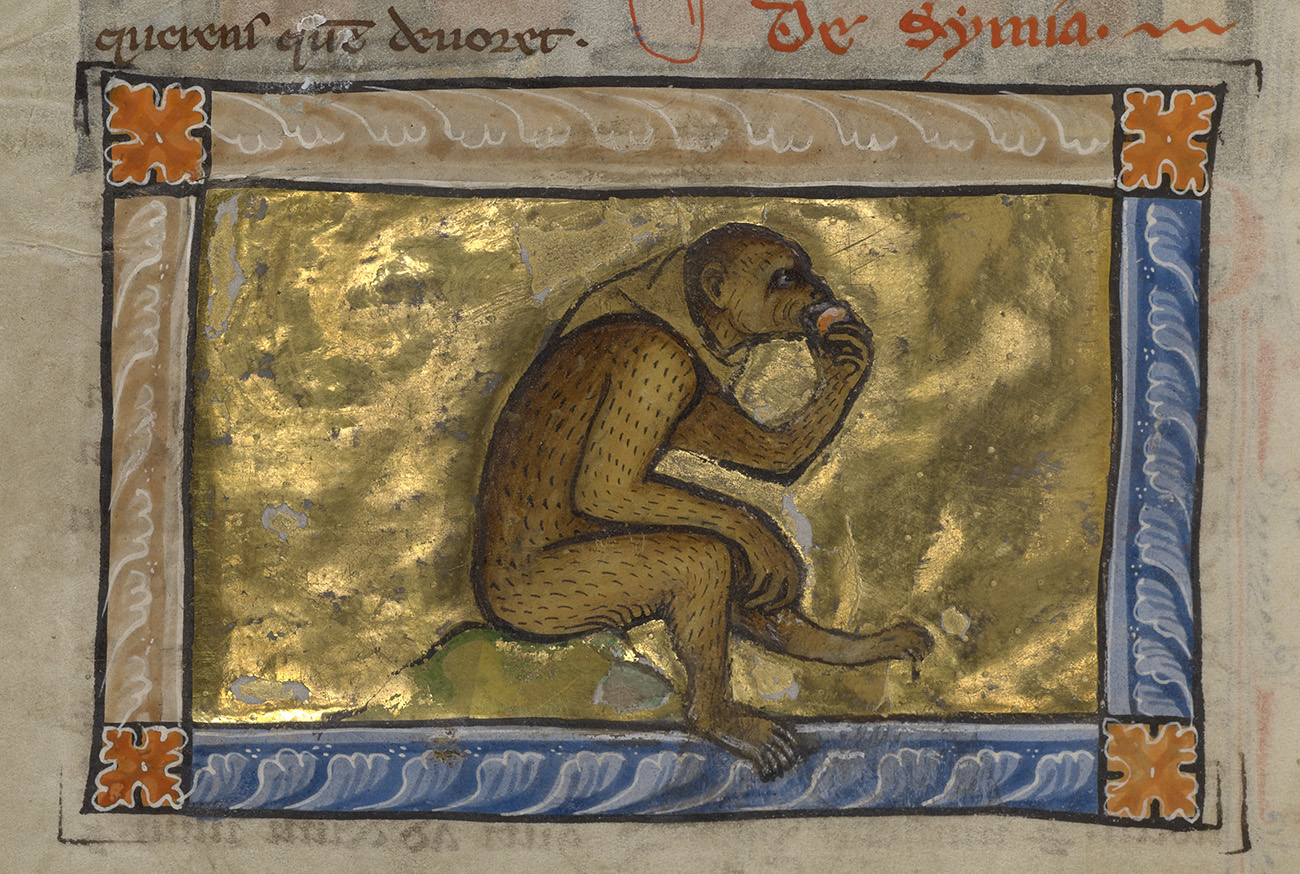Potoooooooo
Contributor
https://blogs.getty.edu/iris/monkey-see-monkey-do-monkey-sin/

Bestiaries were medieval manuscripts of real and imagined animals imbued with Christological meanings. Theologians often used these stories for religious teachings, including to validate humans’ preeminence over God’s other creations. Some animals proved difficult to distinguish from humans, however. Due to their biological and behavioral similarities with people, apes threw a wrench into the idea of humans’ superiority over beasts.
The Ape Allegory
In the medieval bestiary, the story of the ape focuses on a mother ape who bears twins, one of whom she loves and the other of whom she hates. As seen in the image at the top of this post, when chased by hunters the mother protects the child she loves while leaving the other to fend for itself on her back. As she runs, she tires from supporting her favored child and drops it to its death, inadvertently allowing the child she hates to survive by clinging onto her back.
This story has various interpretations. Sometimes the mother ape signifies a slave of the flesh; her loved child symbolizes the bodily pleasures she chooses over the goods of the soul, represented by the child she hates. In this version, the hunters represent the devil ready to take her to hell. We learn that there is no benefit to holding onto our pleasures; ultimately, only our sins are left behind.
In the 1200s, blossoming trade caused a rise in wealth in Europe, which helped shape a new interpretation of the ape. Rather than embodying a generic sinner, the ape mother began to be interpreted as a usurer. The child she loves came to symbolize extreme riches, while the one she hates represented the sin of greed.

An Ape and His Apple
Apes were problematic during the Middle Ages for a singular reason: it was hard to tell whether they were humans or beasts. Even without knowledge of evolution, people realized that we are more closely related to apes than to other animals. Apes’ Latin name, simia, originates from their inherent similarities to people—the word is derived from the word similus, meaning “similar.”
Depictions of apes in medieval manuscripts acknowledge these resemblances to man, particularly in features such as the eyes, mouth, hands, and feet. Apes’ postures and behaviors are usually represented as more human-like than beastly. There are even sources dating to the 1100s that remark upon the fact that both human women and she-apes have menstrual cycles. Of course, there are also undeniable differences between apes and men. For example, while an ape can walk on two legs, it prefers all four. The chosen one, Christ, was made as a man, elevating our position above the beasts’. We may lovingly call our children little monkeys, but medieval scholars would have found it insulting to equate humanity with “lesser” beings.

To resolve this theological quandary, medieval scholars concluded that if humans derived from the likeness and goodness of God, then the ape must have originated from the devil. Proof:
The ape lacks a tail, and the devil lost his tail when he fell from God’s grace.
Ancient Egyptian images correlated primates with darkness and evil.
As the devil poorly imitates the Lord, so do apes poorly imitate us.
In medieval art, apes’ faces appear simultaneously human and devilish—an eerie reminder of our own simian side. Such images often show apes mocking people who are hunting, dancing, or courting loved ones, highlighting the frivolity of human actions.
And what are we supposed to think when we see an ape sitting like a human, eating an apple? This apple could stand for earthly pleasures and gluttony, or for the first sin of Eve consuming the forbidden fruit.
Medieval scholars seemed to fear a beast that could replicate our complex behaviors and actions, revealing our own weaknesses in the face of desire. They attempted to separate us from these beasts through God, intellect, and morality. Even today, we justify destroying apes’ and monkeys’ habitats and using them for medical experiments by declaring our physical and intellectual superiority. Perhaps we really are just as beastly as our apeish counterparts.

Bestiaries were medieval manuscripts of real and imagined animals imbued with Christological meanings. Theologians often used these stories for religious teachings, including to validate humans’ preeminence over God’s other creations. Some animals proved difficult to distinguish from humans, however. Due to their biological and behavioral similarities with people, apes threw a wrench into the idea of humans’ superiority over beasts.
The Ape Allegory
In the medieval bestiary, the story of the ape focuses on a mother ape who bears twins, one of whom she loves and the other of whom she hates. As seen in the image at the top of this post, when chased by hunters the mother protects the child she loves while leaving the other to fend for itself on her back. As she runs, she tires from supporting her favored child and drops it to its death, inadvertently allowing the child she hates to survive by clinging onto her back.
This story has various interpretations. Sometimes the mother ape signifies a slave of the flesh; her loved child symbolizes the bodily pleasures she chooses over the goods of the soul, represented by the child she hates. In this version, the hunters represent the devil ready to take her to hell. We learn that there is no benefit to holding onto our pleasures; ultimately, only our sins are left behind.
In the 1200s, blossoming trade caused a rise in wealth in Europe, which helped shape a new interpretation of the ape. Rather than embodying a generic sinner, the ape mother began to be interpreted as a usurer. The child she loves came to symbolize extreme riches, while the one she hates represented the sin of greed.

An Ape and His Apple
Apes were problematic during the Middle Ages for a singular reason: it was hard to tell whether they were humans or beasts. Even without knowledge of evolution, people realized that we are more closely related to apes than to other animals. Apes’ Latin name, simia, originates from their inherent similarities to people—the word is derived from the word similus, meaning “similar.”
Depictions of apes in medieval manuscripts acknowledge these resemblances to man, particularly in features such as the eyes, mouth, hands, and feet. Apes’ postures and behaviors are usually represented as more human-like than beastly. There are even sources dating to the 1100s that remark upon the fact that both human women and she-apes have menstrual cycles. Of course, there are also undeniable differences between apes and men. For example, while an ape can walk on two legs, it prefers all four. The chosen one, Christ, was made as a man, elevating our position above the beasts’. We may lovingly call our children little monkeys, but medieval scholars would have found it insulting to equate humanity with “lesser” beings.

To resolve this theological quandary, medieval scholars concluded that if humans derived from the likeness and goodness of God, then the ape must have originated from the devil. Proof:
The ape lacks a tail, and the devil lost his tail when he fell from God’s grace.
Ancient Egyptian images correlated primates with darkness and evil.
As the devil poorly imitates the Lord, so do apes poorly imitate us.
In medieval art, apes’ faces appear simultaneously human and devilish—an eerie reminder of our own simian side. Such images often show apes mocking people who are hunting, dancing, or courting loved ones, highlighting the frivolity of human actions.
And what are we supposed to think when we see an ape sitting like a human, eating an apple? This apple could stand for earthly pleasures and gluttony, or for the first sin of Eve consuming the forbidden fruit.
Medieval scholars seemed to fear a beast that could replicate our complex behaviors and actions, revealing our own weaknesses in the face of desire. They attempted to separate us from these beasts through God, intellect, and morality. Even today, we justify destroying apes’ and monkeys’ habitats and using them for medical experiments by declaring our physical and intellectual superiority. Perhaps we really are just as beastly as our apeish counterparts.
